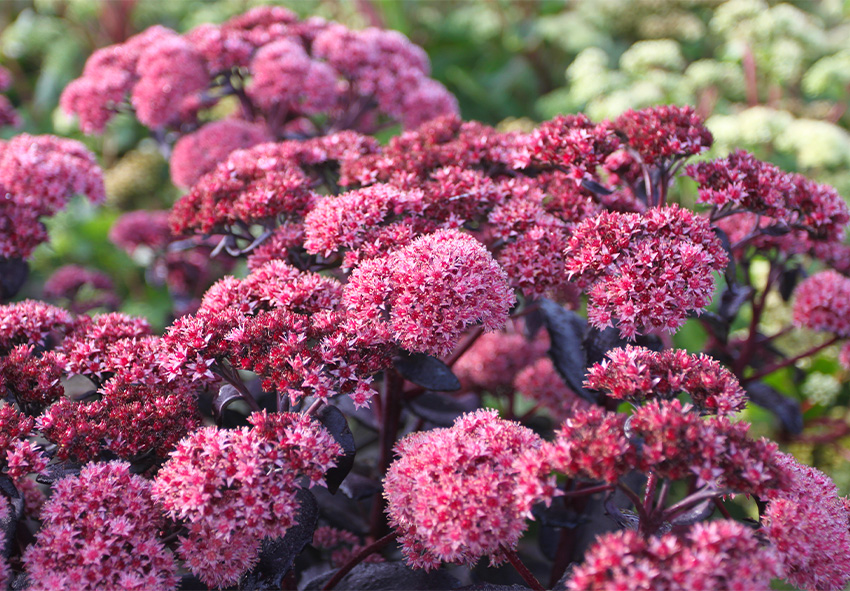Sedum, commonly known as Stonecrop, is a diverse and popular group of succulents cherished by gardeners for their versatility, vibrant colors, and ease of care. These hardy plants are well-suited to various garden styles, from rock gardens and borders to container arrangements. Understanding the specific needs of Sedum, including optimal planting and care techniques, is essential for cultivating healthy and visually appealing plants. Our gardening blog is a perfect place to find all the information you need!
Understanding Sedum
Understanding the diversity and characteristics of Sedum is essential for maximizing their beauty and health in your garden. This section covers the various types of Sedum, highlighting differences between upright and trailing varieties and explaining their unique qualities.
Varieties of Sedum
Sedum species come in many forms, ranging from low-growing ground covers to tall, upright varieties. Some of the most common types include:
| Variety | Colour | Flowering Period | Fragrance | Particularities |
| Sedum spectabile (Autumn Joy) | Pink, Red | Late Summer to Fall | No | Popular for its large, showy flower heads; attracts butterflies. |
| Sedum spurium (Dragon’s Blood) | Pink, Red | Summer | No | Groundcover with red foliage; drought-tolerant. |
| Sedum reflexum (Blue Spruce) | Yellow | Summer | No | Needle-like blue-green leaves; excellent for rock gardens. |
| Sedum acre (Goldmoss Sedum) | Yellow | Late Spring to Early Summer | No | Low-growing; spreads quickly; tolerates poor soil. |
| Sedum album (White Stonecrop) | White, Pink | Summer | No | Evergreen with changing foliage colors; resilient in various conditions. |
Benefits of Growing Sedum
One of the main attractions of Sedum is its low maintenance requirements. These succulents are exceptionally drought-tolerant, making them ideal for xeriscaping and low-water gardens. They thrive in poor soils where other plants might struggle, and their fleshy leaves store water, allowing them to survive dry spells. In landscaping, Sedum can be used in a variety of ways, including in rock gardens, as ground cover, or in containers, where they can add a splash of color and texture. Their adaptability also makes them excellent choices for both novice and experienced gardeners.
Planting Sedum
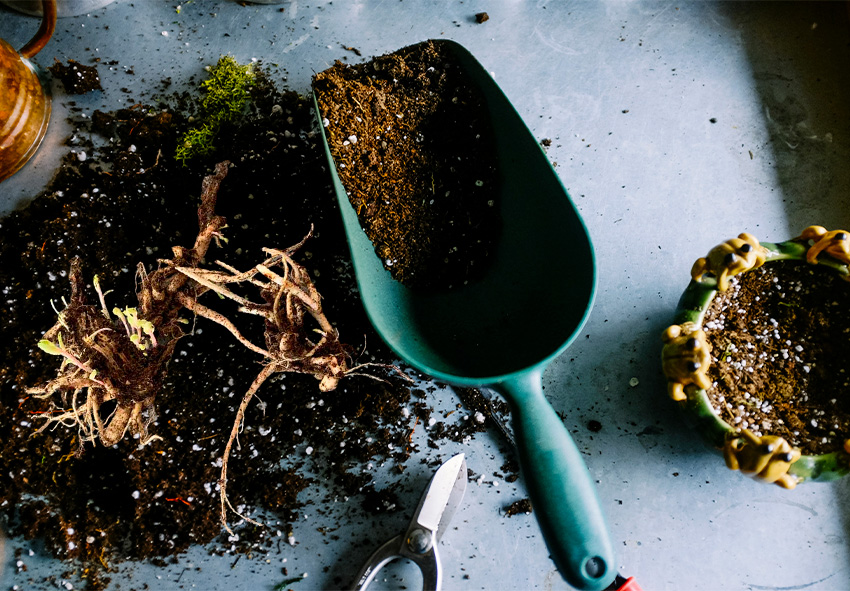
Proper planting is the foundation of a thriving Sedum garden. Here, we discuss how to choose the right location, the best time to plant, and the techniques for planting Sedum, whether you’re using cuttings or divisions.
Choosing the Right Location
Sedum thrives in sunny locations, requiring at least 6 hours of direct sunlight daily to ensure robust growth and vibrant coloration. These plants are highly adaptable but prefer well-draining soil to prevent root rot. It’s important to consider space and planting density, especially for upright varieties, which may need more room to spread, while trailing types can be planted more densely to create lush ground cover.
Best Time to Plant Sedum
The optimal time for planting Sedum bulbs is during the spring or early fall when temperatures are mild, allowing the plants to establish roots before the extremes of summer heat or winter cold. It’s crucial to consider your local climate and hardiness zones; Sedum generally thrives in USDA zones 3-9, but specific varieties may have different tolerance levels.
How to Plant Sedum
Planting Sedum, also known as Stonecrop, is a straightforward process that can be done with either cuttings or divisions. Here’s a step-by-step guide:
1. Prepare the Soil
- Soil Amendment: If the soil is heavy or clay-like, mix in coarse sand or fine gravel to enhance drainage. You can also add organic matter, such as compost, to improve soil fertility.
- Site Preparation: Clear the area of weeds and debris. Rake the soil to create a smooth, level planting surface.
2. Planting Sedum Cuttings
- Cuttings Selection: Choose healthy, disease-free stems. Cut a section about 2-4 inches long.
- Planting Depth: Insert the cutting into the soil, burying the stem about halfway. Ensure the cuttings are spaced according to the variety’s mature size, typically 6-12 inches apart.
- Watering: Lightly water the cuttings to help them settle into the soil. Avoid overwatering, as Sedum is drought-tolerant and susceptible to rot in overly wet conditions.
3. Planting Sedum Divisions
- Dividing Mature Plants: Gently dig up mature Sedum plants and separate them into smaller clumps. Each clump should have a healthy root system.
- Planting: Place the divisions in the prepared holes, ensuring the roots are spread out. Backfill with soil and firm gently around the plants.
- Spacing and Watering: Space the divisions according to the mature size of the variety. Water lightly to help the plants establish.
4. Aftercare
- Watering: Water newly planted Sedum moderately until established. Once established, they require minimal watering.
- Mulching: Apply a thin layer of gravel mulch around the base to help retain moisture and suppress weeds.
- Maintenance: Monitor the plants for pests and diseases, and remove any weeds that may compete for nutrients.
Caring for Sedum
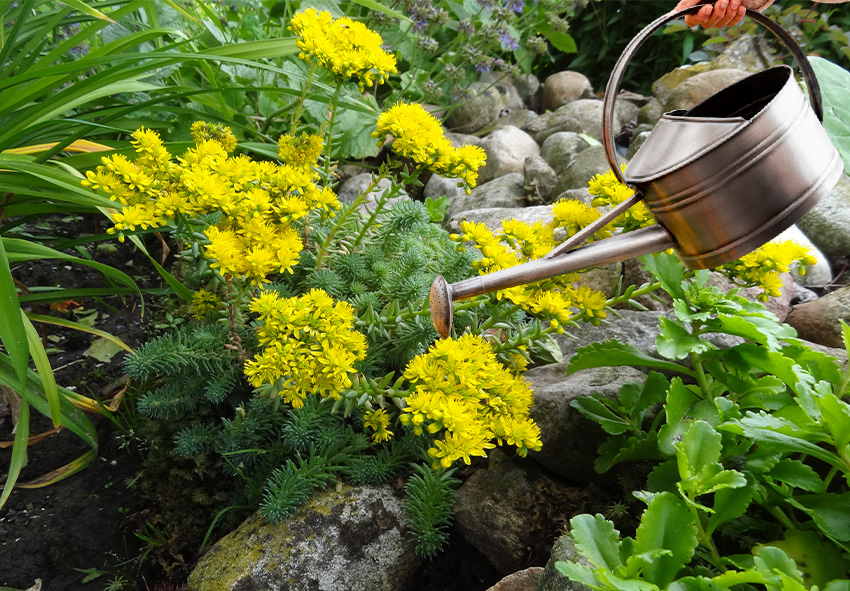
Sedum plants are known for being low-maintenance, but they still require some care to look their best. In this section, you’ll learn about the watering, fertilizing, and pruning needs of Sedum, along with tips for maintaining their health and appearance throughout the growing season.
Watering Needs
Sedum has minimal watering needs due to its succulent nature, storing water in its leaves. Overwatering is a common issue that can lead to root rot. It’s best to water Sedum deeply but infrequently, allowing the soil to dry out completely between waterings. This watering regime mimics their natural, arid habitats.
Fertilizing Sedum
Sedum requires little fertilization but benefits from a balanced, slow-release fertilizer in the spring to support new growth. Excessive fertilization can lead to leggy growth and reduced flowering. A soil test can help determine the need for additional nutrients, particularly in poor soils.
Pruning and Maintenance
Regular pruning helps maintain the shape and health of Sedum plants. Deadheading spent flowers encourages further blooming and keeps the plants looking tidy. In late fall or early spring, cut back any leggy or damaged stems to promote new, vigorous growth. For ground-covering varieties, periodic thinning may be necessary to prevent overcrowding and ensure good air circulation, which helps prevent disease.
Pest and Disease Management

While generally hardy, Sedum can occasionally be affected by pests and diseases. This part of the guide will help you identify common problems, such as aphids and fungal infections, and provide strategies for prevention and treatment, ensuring your plants remain vibrant and healthy.
Common Pests
Sedum, while generally resilient, can sometimes fall victim to pests such as aphids and mealybugs. Aphids are small, sap-sucking insects that can cause foliage to curl and stunt plant growth. Mealybugs, characterized by their white, cottony appearance, can also sap nutrients from the plants, leading to weakened growth. Natural pest control methods, such as introducing ladybugs, can help manage these pests. In more severe cases, insecticidal soaps or neem oil can be used to control infestations.
Disease Prevention
Sedum is susceptible to diseases like fungal infections and root rot, particularly in poorly drained soil or overly humid conditions. Recognizing symptoms such as black spots on leaves or mushy roots is crucial for early intervention. Preventative measures include:
Disease Prevention for Sedum
Preventing diseases in Sedum plants involves proper care and maintenance practices. Here are some effective strategies:
- Ensure Proper Drainage: Sedum requires well-drained soil to prevent root rot and other fungal diseases. Avoid heavy, waterlogged soils. If your soil is heavy or clay-like, incorporate sand, gravel, or organic matter to improve drainage.
- Optimal Watering Practices: Water Sedum sparingly, as they are drought-tolerant and prone to rot if kept too wet. Water the plants at the soil level, avoiding overhead watering, which can promote fungal infections.
- Proper Plant Spacing: Space plants appropriately to allow for good air circulation, which helps prevent fungal diseases. Do not plant Sedum too closely together, as this can create a humid environment conducive to disease.
- Regular Monitoring and Maintenance: Regularly check Sedum for signs of disease, such as discoloration, wilting, or unusual spots. If disease symptoms are noticed, promptly remove and dispose of affected leaves or plants to prevent the spread.
- Use Sterilized Tools: Always use sterilized tools when pruning or dividing Sedum to prevent the introduction of pathogens. Clean tools with a solution of bleach and water after use, especially if you suspect disease.
- Avoid Over-Fertilization: Use a balanced, low-nitrogen fertilizer, as excessive nitrogen can lead to soft growth, which is more susceptible to diseases. Sedum does not require heavy fertilization. Over-fertilizing can weaken plants and make them more prone to diseases.
Propagating Sedum
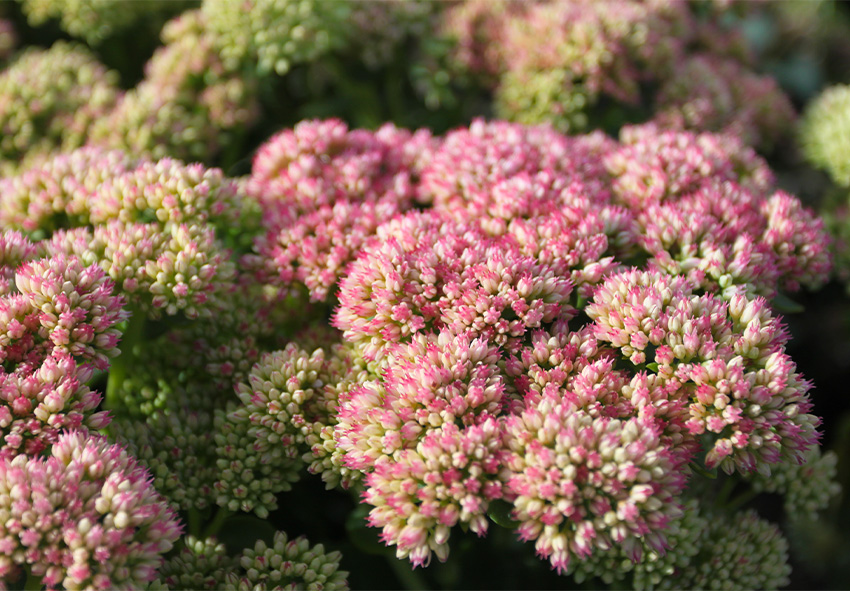
Propagation is an easy way to expand your Sedum collection or share plants with friends. Here, we’ll guide you through the processes of propagating Sedum by cuttings and division, offering step-by-step instructions to ensure success.
Propagation by Cuttings
Propagating Sedum from cuttings is an easy and efficient way to increase your plant collection. Start by cutting a healthy stem, allowing it to dry and callous over for a few days. This step helps prevent rot when the cutting is planted. Once dried, place the cutting in a well-draining soil mix and water sparingly until roots develop. This method is best done in spring or early summer when the plants are actively growing.
Propagation by Division
Dividing mature Sedum plants is another effective propagation method. To divide, carefully dig up the entire plant and gently separate the root clumps, ensuring each division has a good portion of roots and shoots. Replant the divisions immediately, watering them well to help establish the new plants. This method is particularly useful for rejuvenating older plants and is best done in early spring or late fall.
Using Sedum in Garden Design
Sedum’s versatility makes it a favorite in garden design, from ground covers in rock gardens to striking container arrangements. In this section, explore creative ways to incorporate Sedum into your landscape, enhancing your garden’s aesthetic appeal and functionality.
Landscaping with Sedum
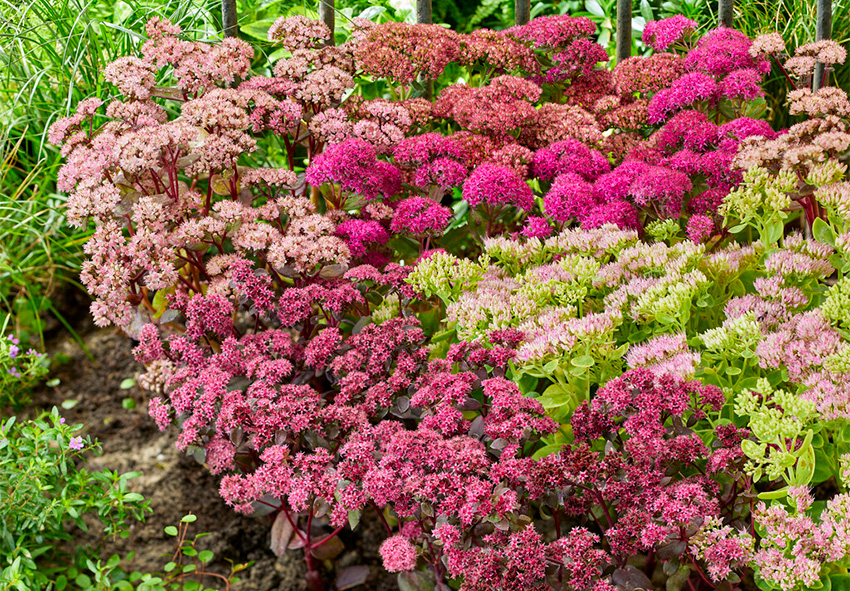
Sedum’s versatility makes it an excellent choice for various landscaping projects. They can be used in different ways, like:
- Create Ground Covers: Sedum varieties such as Sedum ‘Dragon’s Blood’ or Sedum ‘Sunny Border Blue’ make excellent ground covers due to their spreading nature and low height. Use them to cover large areas or fill in gaps between other plants, providing a lush, green carpet with seasonal blooms.
- Design Rock Gardens: Sedum’s drought tolerance and low maintenance make it ideal for rock gardens. Plant them among rocks, gravel, and other drought-resistant plants to create a natural, low-water landscape that thrives in sunny locations.
- Accent Borders and Edges: Use Sedum to line garden beds or pathways. Varieties like Sedum ‘Autumn Joy’ or Sedum ‘Matrona’ add texture and color to borders, creating a striking visual contrast with taller plants and providing seasonal interest.
- Mix with Ornamental Grasses: Combining Sedum with ornamental grasses can create a dynamic and visually appealing garden design. The contrasting textures and colors of Sedum and grasses, such as Miscanthus or Fountain Grass, enhance garden depth and interest.
- Create Vertical Gardens: Sedum can be used in vertical garden designs, such as wall-mounted planters or green walls. Their ability to thrive in limited soil makes them perfect for vertical installations, adding greenery and texture to otherwise unused spaces.
- Incorporate into Slopes and Erosion Control: Utilize Sedum on slopes or areas prone to erosion. Their spreading habit and root structure help stabilize soil and prevent erosion, while their low maintenance requirements make them a practical choice for these challenging areas.
Sedum in Containers
Sedum is also ideal for container gardening, both indoors and outdoors. In pots, they can be arranged to showcase their unique foliage and flower colors, adding interest to patios, balconies, and indoor spaces. When designing Sedum container arrangements, consider using a variety of forms and colors to create depth and contrast. Ensure containers have adequate drainage to prevent waterlogging, which can harm these drought-tolerant plants.
Conclusion
Sedum offers a wonderful opportunity to experiment with different varieties and gardening styles. Whether used in garden beds, rock gardens, or containers, Sedum provides a low-maintenance and visually appealing option for gardeners of all skill levels. Their resilience and versatility make them a valuable addition to any garden.
Frequently Asked Questions (FAQs) about Sedum
1. What are the best varieties of Sedum for beginners?
For beginners, the best Sedum varieties are those that are low-maintenance and adaptable to a range of conditions. Sedum ‘Autumn Joy,’ Sedum ‘Dragon’s Blood,’ and Sedum ‘Angelina’ are excellent choices. They are hardy, easy to grow, and provide attractive foliage and blooms throughout the growing season.
2. How often should I water Sedum plants?
Sedum plants are drought-tolerant and typically require minimal watering. Water them thoroughly when planting, and then allow the soil to dry out between waterings. Generally, watering once every 2-3 weeks is sufficient during dry periods. Overwatering can lead to root rot, so ensure the soil is well-draining.
3. When is the best time to plant Sedum?
The best time to plant Sedum is in the spring or early fall. Planting during these seasons allows the plants to establish their roots before the extreme temperatures of summer or winter. Sedum can be planted in well-draining soil and prefers a sunny location.
4. What are common pests and diseases that affect Sedum?
Common pests affecting Sedum include aphids, mealybugs, and spider mites. Diseases such as powdery mildew and root rot can also occur. To manage pests, use natural predators like ladybugs and lacewings, and consider organic insecticidal soaps if needed. To prevent diseases, ensure proper air circulation, avoid overwatering, and remove any affected plant material promptly.
5. Can I order Holland Sedum from your online store?
Yes, you can! Our online store Dutch-bulbs.com offers a wide selection of Sedum plants, including different varieties and colors. We take pride in providing top-quality plants that are carefully cultivated and shipped with care to ensure they reach you in perfect condition.
Published: 02.08.2024

